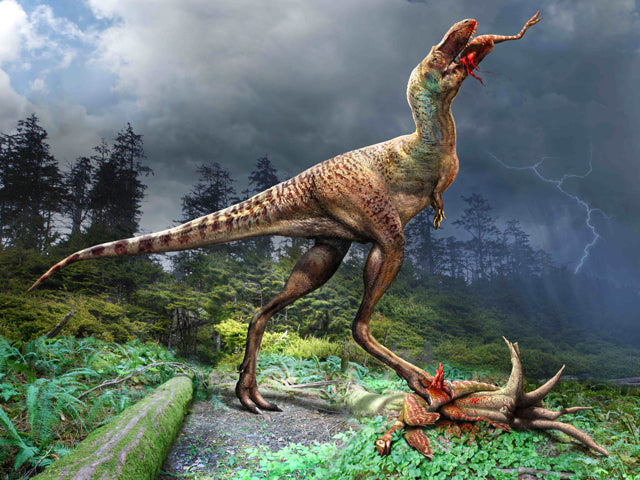Young gorgosaurs dine from their own children’s menu—think small, young prey—and as they grow occupy different ecological niches. Slender in body and limb, with narrow skulls lacking the ability to crush bone, juveniles dined appropriate to their size and abilities. (It also meant they didn’t have to compete with the hunting habits of surrounding adults.) Around the age of eleven, on the cusp of adulthood, when their skulls and teeth were sturdy enough to crush the bones of large herbivores, they sought out hadrosaurs, sauropods, and ceratopsians, to name a few. This discovery offers the first physical evidence of dietary changes accompanying gorgosaur maturity.
As we prepare to feast on big birds (a/k/a avian dinosaurs) for Christmas, before we reach for the drumstick, let us first pay tribute to a young Gorgosaurus who dined on similar limbs, about 75 million years ago, in today’s Canada.
This ancestral relative of T. rex had ingested whole hind legs from a pair of young feathered caenagnathids, Citipes elegans. They were consumed as two distinct meals, based on different phases of digestion. The Gorgosaurus tore off the meaty hind limbs, leaving the small and less appetizing bodies behind.
Paleontologists from the Royal Tyrrell Museum of Paleontology, in Drumheller, Alberta, recently announced this extraordinary discovery, the first tyrannosaur ever found with preserved stomach contents.
Also found were a skull, pelvis, and intact left side of the body, according to the research published in the journal Science Advances.
The five-to-seven-year-old Gorgosaurus libratus was unearthed in Dinosaur Provincial Park, in Alberta, in 2009; the stomach contents emerged during the process of cleaning and preparation.
Apparently, the sated though unfortunate tyrannosaur perished in a river and was promptly buried in silt, creating the ideal conditions for the remarkable state of preservation.
As it turns out, young gorgosaurs dine from their own children’s menu—think small, young prey—and as they grow occupy different ecological niches. Slender in body and limb, with narrow skulls lacking the ability to crush bone, juveniles dined appropriate to their size and abilities. (It also meant they didn’t have to compete with the hunting habits of surrounding adults.) Around the age of eleven, on the cusp of adulthood, when their skulls and teeth were sturdy enough to break the bones of large herbivores, they sought out hadrosaurs, sauropods, and ceratopsians, to name a few.
This discovery offers the first physical evidence of dietary changes accompanying gorgosaur maturity.
Fellow gorgosaurs have been found not only in the province of Alberta, but the state of Montana as well.
Source: “Exceptionally preserved stomach contents of a young tyrannosaurid reveal an ontogenic dietary shift in an iconic extinct predator” by Francois Therrien, Darla K. Zelenitsky, Jared T. Voris, Gregory M. Erickson, Philip J. Currie, Christopher L. Debuhr, and Yoshitsugu Kobayashi, published in Science Advances.
